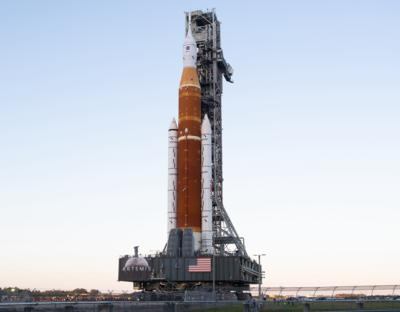Bloated Project Epitomizes Reckless Spending
NASA's Space Launch System is an American super heavy-lift expendable launch vehicle by which NASA—under the auspices of the agency’s Artemis program—intends to return human beings to the surface of Earth’s moon.

The first SLS launch was made on 16 November 2022 and impelled an unmanned specimen of Lockheed-Martin’s Orion spacecraft successfully moonward.
Past successes notwithstanding, the SLS program, as of May 2023, is north of $6-billion over-budget and more than six-years behind schedule—so states a scathing new audit undertaken by NASA’s Inspector General.
Worse still, the Inspector General’s (IG) report portends additional costs and schedule increases which, if left uncorrected, are apt to jeopardize the Artemis program’s very existence.
By the planned 2025 launch of NASA’s Artemis III mission—the one slated to put astronauts boots-down in the vicinity of the lunar south-pole—the agency’s total spending on the Artemis program is expected to have surpassed $93-billion—including $23.8-billion given over to the development of the SLS system through 2022.
Designed and manufactured by United Launch Alliance—a consortium comprising Lockheed-Martin Space and Boeing Defense, Space & Security—the SLS burns up four Aerojet Rocketdyne RS-25 liquid-fuel cryogenic rocket engines with every launch. The engines—formerly known as Space Shuttle Main Engines (SSME)—each produce some 418,000 lbf thrust at liftoff.
Though not a new engine—the platform’s heritage traces back to the 1960s—the RS-25’s reliability, safety, and output have been improved over numerous upgrades.
As SLS rockets and the entirety of the components therein are wholly expendable, the inevitable expenditure of the final extant RS-25 engine will see NASA fit the SLS with Aerojet Rocketdyne’s RS-25E rocket engines—RS-25 variants ostensibly 11-percent more powerful and thirty-percent cheaper than the legacy engines.
An immense machine requiring commensurately immense liftoff thrust, the SLS, in addition to its quartet of RS-25 engines, makes use of two Northrop Grumman solid rocket-boosters.
The SLS’s founding architects posited, albeit erroneously, that incorporating older technologies, such as the RS-25 engines, into the rocket’s design would help mitigate costs—a miscalculation of which the IG’s report surmised: "These [cost] increases are caused by interrelated issues such as assumptions that the use of heritage technologies from the Space Shuttle and Constellation Programs were expected to result in significant cost and schedule savings compared to developing new systems for the SLS. However, the complexity of developing, updating, and integrating new systems along with heritage components proved to be much greater than anticipated."

To date, only five of the 16 RS-25 engine adaptations have been completed. What’s more, scope and cost increases have similarly distorted the SLS booster contract—which in the years since the Artemis program’s 2010 inception has increased from $2.5-billion to $4.4-billion and fallen five-years behind schedule.
NASA’s Inspector General ascribed blame, also, to the agency’s proclivity for cost-plus contracts, unwise covenants by which suppliers may easily and unethically inflate budgets at taxpayer expense. The IG recommended NASA henceforth issue only fixed-price contracts.
In all the IG’s audit set forth a total of eight recommendations—the entirety of which NASA’s leadership has agreed to implement.
 ANN's Daily Aero-Term (12.13.25): Light Gun
ANN's Daily Aero-Term (12.13.25): Light Gun Aero-News: Quote of the Day (12.13.25)
Aero-News: Quote of the Day (12.13.25) NTSB Final Report: Gippsland GA-8
NTSB Final Report: Gippsland GA-8 Classic Aero-TV: Historically Unique -- Marlin Horst's Exquisite Fairchild 71
Classic Aero-TV: Historically Unique -- Marlin Horst's Exquisite Fairchild 71 Airborne 12.12.25: Global 8000, Korea Pilot Honors, AV-30 Update
Airborne 12.12.25: Global 8000, Korea Pilot Honors, AV-30 Update




